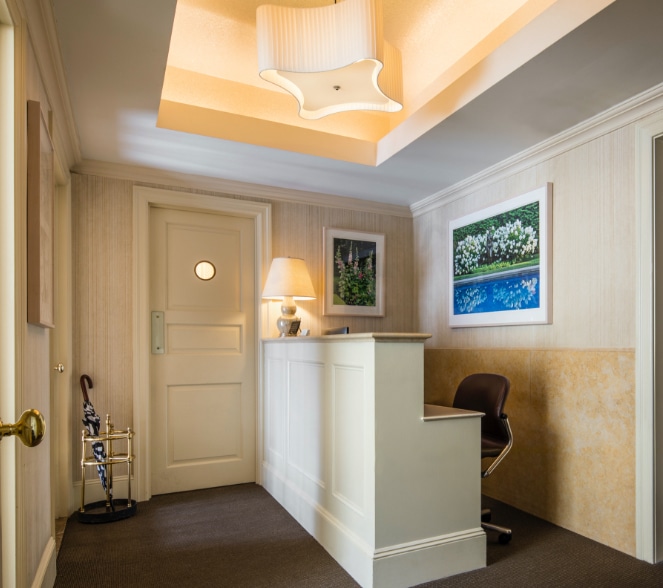What is a rhytidectomy, or facelift?
Rytid is the medical term for wrinkle, and –ectomy means remove. Rhytidectomy therefore, is a procedure that removes facial wrinkles. It is better known by the colloquial term facelift.
There are several popular misconceptions about facelifts. First, it does not treat the entire face. It is designed to eliminate jowls and tighten the loose neck (Figure 1). It does not by itself improve the appearance of the eyes (even the lower eyes) or the forehead. Most importantly, it does not change the appearance of the central face, meaning the corners of the mouth are not distorted when the procedure is properly performed. The folds that extend from the crease in the nose to the corner of the mouth (laugh lines or nasolabial folds) do not disappear when a facelift is performed. However, the lower portion of the nasolabial folds are softened considerably, and the downward extension of the nasolabial folds seen in some individuals that reach almost to the jawline (marionette lines) are usually eliminated (Figure 2).


What is the goal of facelift surgery?
A facelift is intended to make a person look fresher, not fundamentally different. When properly performed it reverses aging changes without leaving telltale signs. It is an effective way to “turn back the clock” and the beneficial effects will last for about ten years.
Who is a candidate for a facelift?
Most women become candidates for a facelift sometime after forty-five and men about ten years later. Jowl formation and loose neck skin are the most common indications for surgery. The decision to operate depends not only on the severity of the problem but the individual’s reaction to it. Early aging signs may be insignificant to some but enough for others to consider surgery. Facelifts are not performed on a preventive basis however. There must be enough aging changes present to warrant the procedure. That said, results are generally better in younger patients with good skin quality.
I only want my neck done. Do I really need a facelift?
Everyone wants the least amount of surgery needed to achieve the best result. However, it is not logical to expect that a simple “tuck” or liposuction of the neck alone will reverse decades of progressive aging. Even more extensive neck lifts are limited by their direction of pull and are much less effective than facelifts in improving the neck. There are exceptions, however, in some young women and older men. This is rarely possible and the results of “doing less” are usually disappointing. Objection to needing a facelift is unrealistic when aging changes are significant.
Some individuals, though few, do benefit from a neck lift only. They are usually young and have very minimal conditions. The amount of tightening possible with a neck lift is limited by restricted incision access behind the ears (Figure 3, left). Moreover, the skin has to be pulled hard to adequately tighten the neck with this method. High skin tension resulting from this predisposes to thick or wide scars. Rotation of the lower cheeks and neck together in a facelift tightens the neck more effectively. Overall scar quality is far better because skin tension is distributed over a broader area.
What about injectables instead of a facelift?
Restylane® and Juvéderm® are examples of fillers used to treat problems of volume loss, grooves, and static wrinkles (wrinkles observed with the face in repose). BOTOX®, Jeuveau®, and Dysport® are temporary paralyzing agents used to treat wrinkles from hyperactive muscles, like the frown lines between the eyebrows.
What about other alternatives to a facelift?
Nonsurgical skin tightening methods include the use of radiofrequency (Thermage), ultrasound (Ultherapy) and laser-based devices. These modalities can produce subtle improvements in mild cases but are ineffectual in those with true skin laxity. They are not a substitute for a facelift nor an effective temporizing measure to delay having a facelift.
Stem cell facelifts are not facelifts at all. This method isolates fat stem cells that are claimed to have rejuvenating properties on the skin. The fat is injected into the face to enhance shape in areas that exhibit hollowing. It can be used as an adjunctive measure but is not a substitute for surgery.
The Lifestyle lift is a surgical procedure. Barbed sutures that resemble miniature fish hooks are passed into the cheeks through scalp incisions. The sutures “catch” the tissue when they are pulled upward, elevating the cheeks as they are tied under tension. The results are often imperceptible, and not long lasting. Problems with suture breakage, slipping, and skin dimpling can occur.
Where are the scars in a facelift?
The incision typically starts in the scalp just above the ear, courses downward following the curve of the ear, disappears behind the small protruding cartilage in front of the ear, emerges to course around the earlobe, and runs in the crease behind the ear (Figure 3, center). It will either stop there in those with little neck laxity, or continue backward into the hair behind the ear in those who are generally over 60 and have looser neck skin (Figure 3, right).
A separate scar is often necessary under the chin in order to eliminate the muscle cords in the front of the neck. All facelift scars are permanent but fade with time, most being inconspicuous after one year (Figure 4). It is not necessary to cut the hair at the time of surgery.

What happens under the skin, at the deeper layer?
Facelifts consist of more than just skin tightening. There is an important layer under the skin called the SMAS, which is short for Superficial Musculo-Aponeurotic System. The SMAS is made of strong fibrous tissue and fat. Tightening the SMAS layer eliminates the jowls, restores cheek contour, and softens the nasolabial folds. It also reduces the amount of pull necessary on the skin, thereby greatly aiding in achieving a natural appearance and good quality scars. There are several ways to tighten the SMAS layer depending on individual anatomy. A simple tightening is done if the main goal is eliminating the jowls. A much more extensive lifting and tightening is performed if the cheeks look deflated too.
There is a thin sheet of muscle in the neck called the platysma. It blends into the SMAS in the lower cheek. This muscle is tightened together with the SMAS to improve neck contour and help reduce neck skin laxity (Figure 5).
Which is better, SMAS tightening or deep plane lift?
A deep plane lift is a variation on SMAS technique where the skin and SMAS layers are lifted together and not separately. It is quicker but has the disadvantage of not allowing the skin and SMAS layers to be tightened in the slightly different directions necessary to achieve optimal aesthetic results. It also places the underlying facial nerve branches at greater risk for injury. This method is not used by traditionally trained plastic surgeons. It is employed instead by “facial plastic surgeons” who are graduates of otolaryngology (ear, nose and throat) programs.
How is the loose neck skin under the chin addressed?
Facial aging changes commonly include the development of prominent neck cords under the chin. These cords, or bands, form two vertical folds that consist of loose platysma muscle edges underneath (Figure 6, left). These bands also contribute to poor neck contour from the side (Figure 6, right). Minimal bands do not require specific treatment other than pulling the platysma from the side as part of SMAS cheek tightening. However, most patients benefit from sewing the loose muscle edges together in the middle through a separate incision under the chin (Figure 7). This eliminates the visible cords and also improves neck contour on the side view (Figure 8). Removing excess fat under the chin through this same incision further improves neck shape.



What about the eyes and the forehead?
Aging changes of the forehead and eyes are commonly addressed at the same time as a facelift so that balanced facial rejuvenation is achieved. Hooded upper eyelids and lower eyelid fat pouches can be effectively treated with eyelid surgery. The incisions are hidden in natural creases. Sagging eyebrows associated with deep furrows between them can be treated with a browlift, although the need for this is infrequent. Surgery to improve the forehead and eyelids at the same time as a facelift does not affect recovery time.

What ancillary procedures are there to enhance results?
A facelift does not eliminate fine wrinkles and textural problems of the skin although these conditions are often partially improved. Chemical peels and dermabrasion are adjunctive procedures that can treat fine lines around the eyes and mouth, respectively. These procedures are simple and effective. Dermabrasion can prolong overall recovery though. Additionally, it must be done carefully to avoid permanent skin color changes.
The cartilages of the nasal tip continue to enlarge through life and may result in a prominent tip that droops. Making the tip smaller and raising it enhances overall appearance. This is a both simple and subtle procedure that is focused on the tip without changing the rest of the nose.
Thinning of the upper lip often occurs with aging and is difficult to treat effectively with any method. A lip lift is an ancillary procedure that is not widely applicable but in the right patient can make an improvement.
A chin implant is helpful for those who have a weak chin projection. This can enhance the profile without changing the frontal view significantly (Figure 10). They can also be used to eliminate chin dimpling in those with hyperactive chin muscles. Chin implants are inserted through an incision under the chin and are permanent. There is little awareness of having a chin implant once healed.
The tip of the nose enlarges and droops with advancing age. However it can be raised and reduced by a simple procedure performed through the nostrils. Recovery is minimal.
The skin between the nose and upper lip elongates with age. This area can appear to hang like a curtain and conceal the upper teeth in more extreme cases. A lip lift removes skin from under the nose. The lip is pulled up and rolled outward to appear fuller. The scars are well concealed inside and under the nostrils. There is typically little swelling and bruising associated with lip lifts.
Fat grafts can be injected to add volume to selected parts of the face such as the nasolabial folds, the marionette lines, the cheeks, and other areas. However, the longevity of fat grafts is unpredictable. Several injections may be necessary over time to achieve permanent fat build-up.
Where is the surgery performed and how long does it take?
Facelift surgery is performed in the office as an outpatient procedure. Operating time correlates with the severity of the aging changes. A facelift alone usually requires about 4 hours. Upper and lower eyelid surgery adds another hour each. Dermabrasion, chemical peels, and other ancillary procedures do not add much time. All surgery is performed entirely by Dr. Hidalgo.

What type of anesthesia is used?
Surgery is usually performed with deep intravenous sedation combined with local anesthesia. There is no awareness. A board certified anesthesiologist is present for the entire procedure and uses state-of-the-art monitoring equipment.
What are the risks associated with facelift surgery?
The most common complication is a hematoma, occurring in about one percent. A hematoma is an accumulation of blood that forms a lump under the skin. It usually requires removal in the operating room but does not adversely affect either short-term recovery or the long-term result. Other problems such as infection, eye irritation, delayed healing, or excessive scarring can occur but are unusual. Facial nerve injury with weakness of a part of the face can occur on a transient or permanent basis. This is extremely rare. The vast majority of patients do not have any complications.
Why is smoking so harmful for surgery?
Smoking severely reduces blood supply to the skin and also delays healing. Facial skin loss around the ears can occur in those that smoke. Disfiguring scars can result that may require revisional surgery. It is therefore essential to stop smoking completely for at least three weeks before surgery and six weeks after surgery. Simply cutting back is not enough. Nicotine containing patches and gum are equally harmful.
Why do I need nurses after surgery?
Private duty nurses are required for 24 to 48 hours after surgery. They are arranged by our staff. These nurses are specially trained to take care of facelift patients. They monitor vital signs and the surgical site, provide dressing and drain care, administer medications, and assist with feeding and ambulation. They prevent unnecessary activities in order to minimize the possibility of hematoma formation. They meet our patients at the office following surgery and escort them either home or to a hotel to continue postoperative care.
What is the recovery like?
Patients leave the office in a head dressing that is removed by the nurse the next morning. Drains are removed by 48 hours if not sooner. There are normally feelings of tightness in the neck, cheek numbness, and generalized discomfort of the face and neck. Pain, if present, is typically mild. Patients are encouraged to be out of bed as soon as possible.
Swelling and bruising usually subside in two weeks. Makeup to cover residual facial bruising may be used after one week. Eyelid makeup may be applied after ten days. Hair may be washed several days after surgery and colored four weeks later.
Flying and driving are not recommended for two weeks. Mild cardiovascular exercise without impact such as a stationary bike or walking outdoors can begin several weeks after surgery. It is best to wait as long as six weeks before resuming more intense exercise and activities such as jogging, weightlifting, ball sports, yoga, pilates, skiing, and horseback riding.
What are some of the limitations associated with facelift surgery?
There are pre-existing conditions that can adversely influence the outcome of facial surgery. These include thin skin, poor skin elasticity, heavy wrinkling and sun damage, fat atrophy with generalized facial hollowing, unfavorable underlying bone structure, poor healing tendencies, prior facial surgery not well done, and previous injections of silicone and other substances into the face. The best surgical effort will likely achieve a more modest result in the presence of one or more of these factors.
What are the costs involved in having surgery?
There are separate fees for surgery, anesthesia, operating room use, and private duty nurses. Costs also include preoperative lab tests and medical grade photographs.
What are the steps involved in proceeding with surgery?
At the initial consultation your face will be evaluated anatomically and a surgical plan proposed, provided that you are a good candidate for the procedure. Once the plan is agreed upon a surgical date can be scheduled. Photographs and preoperative laboratory studies follow. Patients with significant medical conditions will need to obtain clearance from their internist or specialist beforehand.






